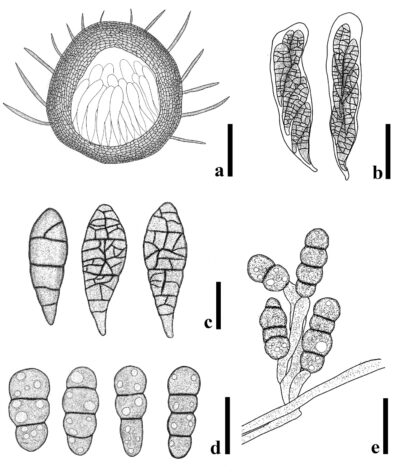Fungalpedia – Note 410, Clavatispora
Clavatispora Boonmee & K.D. Hyde
Citation when using this data: Tibpromma et al. 2024 (in prep.) – Fungalpedia, Ascomycota.
Index Fungorum, Facesoffungi; MycoBank, GenBank, Fig. 1
Classification: Incertae sedis, Venturiales, Pleosporomycetidae, Dothideomycetes, Pezizomycotina, Ascomycota, Fungi
Based on the morphology and phylogeny of LSU, Boonmee et al. (2014) introduced Clavatispora to accommodate the type species Clavatispora thailandica and placed it in the family Sympoventuriaceae. Clavatispora was isolated from dead stems of herbaceous plants in Thailand as a saprobe (Boonmee et al. 2014). Only one species with both sexual and asexual morphs was accepted in this genus. Clavatispora is characterized by setose, ostiolate ascomata, bitunicate asci, dark brown, wedge-shaped to clavate, muriform ascospores; a hyphomycetous asexual state produces ellipsoidal, septate, highly constricted, holoblastic conidiogenous cells, and ellipsoidal to subglobose, pale brown to brown, guttulate, 1–3-septate, constricted, and darkened at septa conidia (Boonmee et al. 2014). Clavatispora is similar to some genera of Pleosporales, Capnodiales, and Hysteriales in dark brown ascomata, bitunicate asci, and muriform brown ascospores (Barr 1990, Boehm et al. 2009, Zhang et al. 2012, Hyde et al. 2013). However, it can be distinguished from other genera by its solitary ascomata, covered by superficial, dark setae, a bright ostiole, and hyphomycetous asexual state (Boonmee et al. 2014). Phylogenetically, Clavatispora is related to Scolecobasidiella, Ochroconis, Scolecobasidium, Fusicladium, and Veronaeopsis in the Sympoventuriaceae. Clavatispora is different in that it has smooth, 1–3-phragmoseptate conidia with constricted septa, whereas in other genera, it has verrucose to denticulate conidia and a conidiogenous apparatus (Boonmee et al. 2014). Clavatispora can be distinguished from other genera based on morphology and multigene phylogeny.
Type species: Clavatispora thailandica Boonmee & K.D. Hyde
Other accepted species: This genus is monotypic.
Figure 1 – Morphological features Clavatispora thailandica. a Ascomata. b Asci. c Ascospores. d Conidia. e Conidiophores with conidia. Scale bars: a–b = 50 µm, c–f = 10 µm. Redrawn from Boonmee et al. (2014).
References
Zhang Y, Crous PW, Schoch CL, Hyde KD. 2012 – Pleosporales. Fungal Diversity 52, 1–225.
Entry by
Liu XF, Center for Yunnan Plateau Biological Resources Protection and Utilization, College of Biological Resource and Food Engineering, Qujing Normal University, Qujing, Yunnan 655011, China; Center of Excellence in Fungal Research, Mae Fah Luang University, Chiang Rai 57100, Thailand; School of Science, Mae Fah Luang University, Chiang Rai 57100, Thailand.
(Edited by Saowaluck Tibpromma, Samaneh Chaharmiri-Dokhaharani, & Achala R. Rathnayaka)
Published online 26 November 2024
